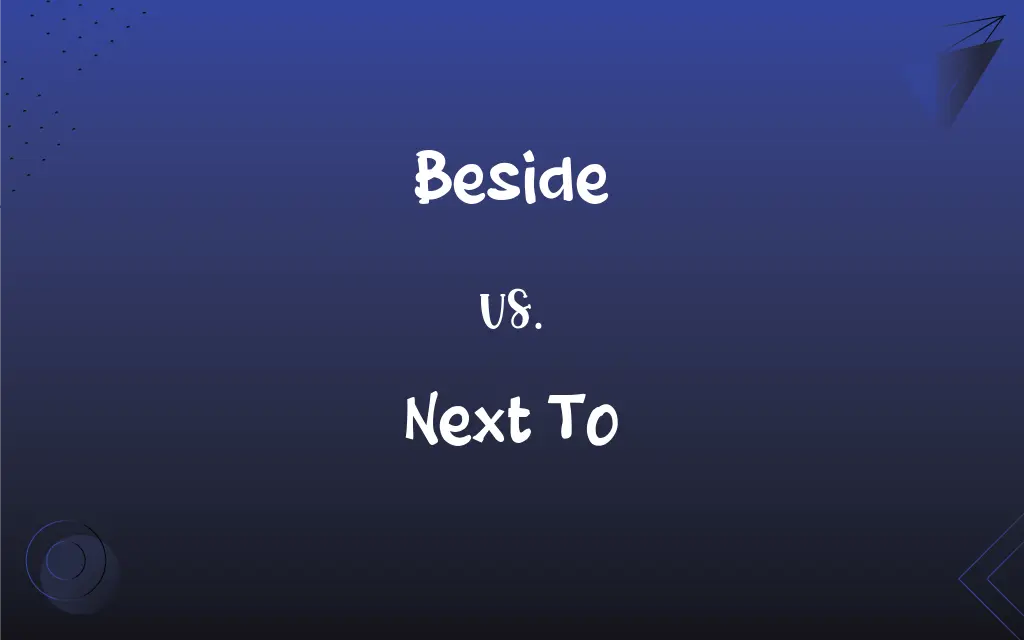Beside vs. Next To: What's the Difference?
Edited by Aimie Carlson || By Janet White || Published on December 20, 2023
Beside and next to both indicate proximity, but "beside" often implies a closer, more intimate positioning, whereas "next to" simply denotes adjacent placement.

Key Differences
Beside often conveys a sense of closeness or alongside-ness, suggesting a position immediately adjacent with a hint of companionship. Next to is more neutral, indicating a position adjacent to another without implying closeness.
In usage, beside can have a slightly more poetic or intimate connotation, used in contexts requiring a sense of closeness or partnership. Next to, on the other hand, is more straightforward and functional, simply denoting spatial adjacency.
Beside can be used to indicate physical proximity, it also has figurative uses, such as in comparisons or contrasts. Next to, however, is almost exclusively used in a literal, spatial sense.
Beside can also imply equality or being on the same level, as in sitting beside someone. Next to merely indicates spatial placement and does not inherently convey equality or companionship.
The choice between beside and next to can depend on the desired emphasis: beside for a closer, more intimate connection, and next to for a simple statement of proximity.
ADVERTISEMENT
Comparison Chart
Connotation
Closeness, companionship
Neutral, simply adjacent
Usage
Poetic, intimate
Straightforward, functional
Figurative Use
Can be used figuratively
Primarily used in literal sense
Implication
Often implies equality
No implication of equality
Desired Emphasis
Intimacy, closeness
Simple proximity
ADVERTISEMENT
Beside and Next To Definitions
Beside
In addition to or apart from.
Beside these issues, we must also consider the budget.
Next To
Following in order or importance.
Next to honesty, he values courage.
Beside
Compared with.
Beside his talent, mine seems insignificant.
Next To
In comparison to.
Next to her cooking, mine seems bland.
Beside
At the side of; next to.
She sat beside her friend at the concert.
Next To
Immediately adjacent to; beside.
The bookstore is next to the coffee shop.
Beside
Indicating location or position.
The lamp stood beside the bed.
Next To
Close to or alongside.
He lives next to the park.
Beside
Symbolizing companionship or support.
He always stood beside her in difficult times.
Next To
In an adjacent position.
Park your car next to mine.
FAQs
Can "next to" indicate emotional closeness?
"Next to" primarily indicates physical proximity, not emotional closeness.
Are "beside" and "next to" interchangeable?
Often, but "beside" can imply a closer, more intimate connection.
Is "next to" always literal?
Generally, "next to" is used in a literal, spatial sense.
Does "beside" imply equality?
"Beside" can imply equality or being on the same level.
Can "beside" be used figuratively?
Yes, "beside" can have figurative uses in comparisons or contrasts.
Can "next to" be used in comparisons?
Yes, but it's more common in spatial contexts.
Is "beside" appropriate for formal writing?
Yes, "beside" can be used in both formal and informal contexts.
Is "beside" more poetic than "next to"?
"Beside" often has a more poetic or intimate connotation.
Does "next to" suggest a sequence?
It can, as in "next in line," but it primarily indicates proximity.
Do "beside" and "next to" have different origins?
Yes, they have different etymological origins but similar meanings.
Is "beside" used in modern English?
Yes, it's still commonly used in both spoken and written English.
Can "next to" imply subordination?
Not typically; it denotes proximity without hierarchical implications.
Are there idiomatic uses for "beside"?
Yes, like "beside oneself" meaning extremely emotional.
Can "next to" convey physical closeness?
Yes, it's often used to express physical adjacency.
Does "beside" carry a more intimate tone?
It can, especially in contexts implying closeness or companionship.
Is "beside" used in navigational instructions?
Yes, it's used to indicate specific locations alongside others.
Do "beside" and "next to" have the same frequency of use?
"Next to" is more commonly used, but "beside" is also frequent in certain contexts.
Can "beside" be used in abstract senses?
Yes, "beside" can be used abstractly, like "beside the point."
Is "next to" common in everyday speech?
Yes, it's widely used in everyday language for indicating location.
Can "next to" be used in formal descriptions?
Absolutely, it's suitable for formal and informal descriptions alike.
About Author
Written by
Janet WhiteJanet White has been an esteemed writer and blogger for Difference Wiki. Holding a Master's degree in Science and Medical Journalism from the prestigious Boston University, she has consistently demonstrated her expertise and passion for her field. When she's not immersed in her work, Janet relishes her time exercising, delving into a good book, and cherishing moments with friends and family.
Edited by
Aimie CarlsonAimie Carlson, holding a master's degree in English literature, is a fervent English language enthusiast. She lends her writing talents to Difference Wiki, a prominent website that specializes in comparisons, offering readers insightful analyses that both captivate and inform.







































































